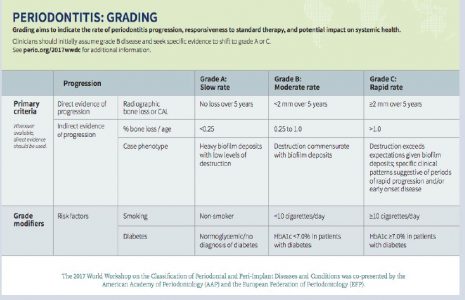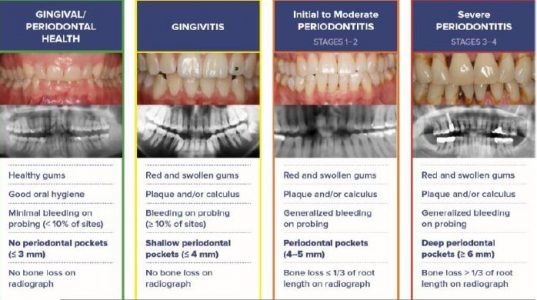Background/Objective
• There are two main types of periodontal diseases:
• Gingivitis
• Periodontitis

Periodontitis


Progression of Periodontal Diseases
Periodontal Disease: an inflammatory disease commonly known as “gum disease” that affects the soft and hard tissues supporting the teeth

Peri-Implants and Gingivitis
• If a client presents with an implant, a peri-implant classification is utilized
• Classification of peri-implant diseases has been identified as its own in order to acknowledge the condition of the implant
• Gingival diseases is broken into two broad categories:
• Dental-plaque induced
• Non-dental plaque induced
• Gingivitis only affects the soft tissues around the teeth – can progress to periodontitis
• Gingivitis can be reversed with efficient oral self-care and professional care
Conclusion
• Staging and grading of periodontal disease are only necessary when clients present with clinical signs and evidence consistent with periodontitis
• Classifying periodontal disease is important in communicating a client’s periodontal status with other dental professionals
• Dental professionals can use the steps available to assess the client’s oral health which will aid in classifying the periodontal status
• Comparisons between clinical attachment loss (CAL) and radiographs are crucial in classifying the periodontal status
Muller. (2019, March 20). Our Thought Leaders' Dilemma. Retrieved from https:// scholarlyperio.wordpress.com/2019/03/20/our-thought-leaders-dilemma/#more-7930 Caton, J. G., Armitage, G., Berglundh, T., Chapple, I.L.C., Jepsen, S., Kornman, K. S., Tonetti, M. S. (2018). A new classification scheme for periodontal and peri-implant diseases and conditions - Introduction and key changes from the 1999 classification. Journal of Periodontology, 89(S1), S1-S8. doi:10.1002/jper.18-0157 American Academy of Periodontology. (n.d.). About the American Academy of Periodontology. Retrieved from https://www.perio.org/about-us

